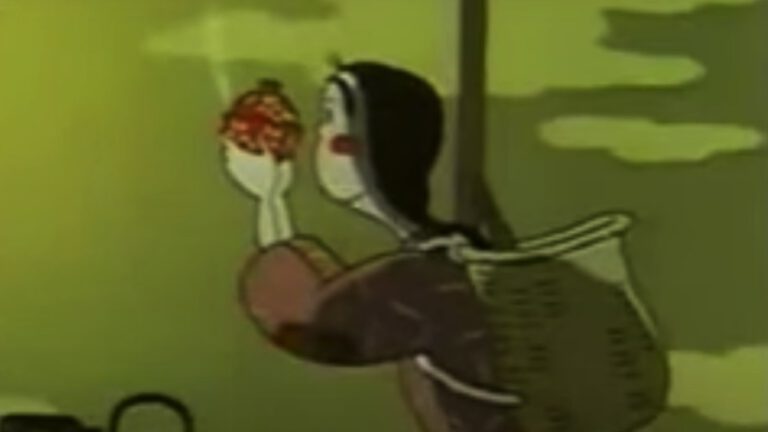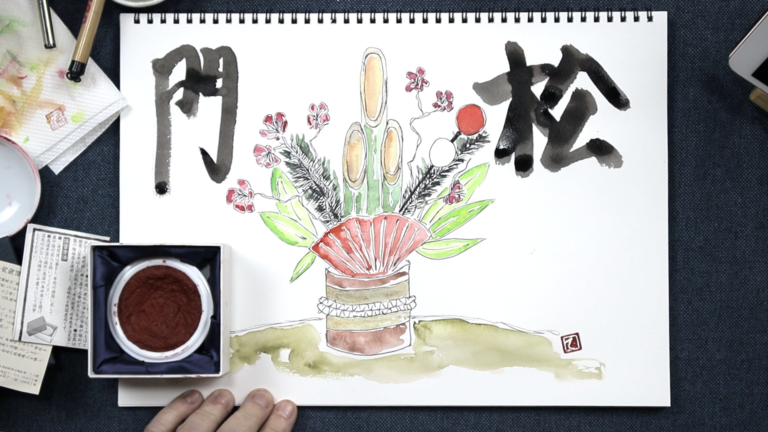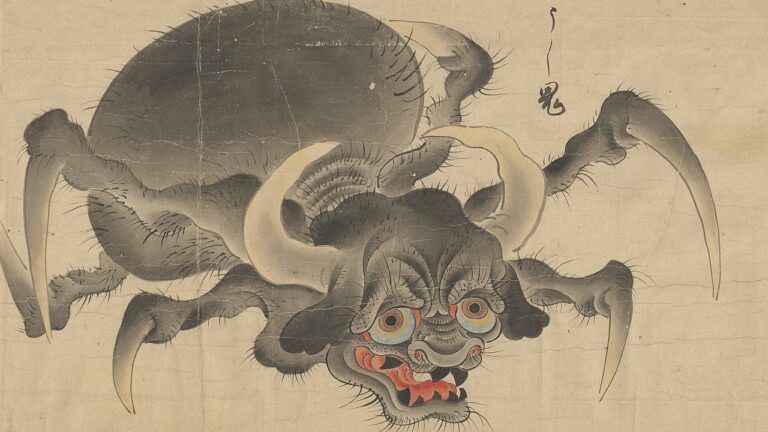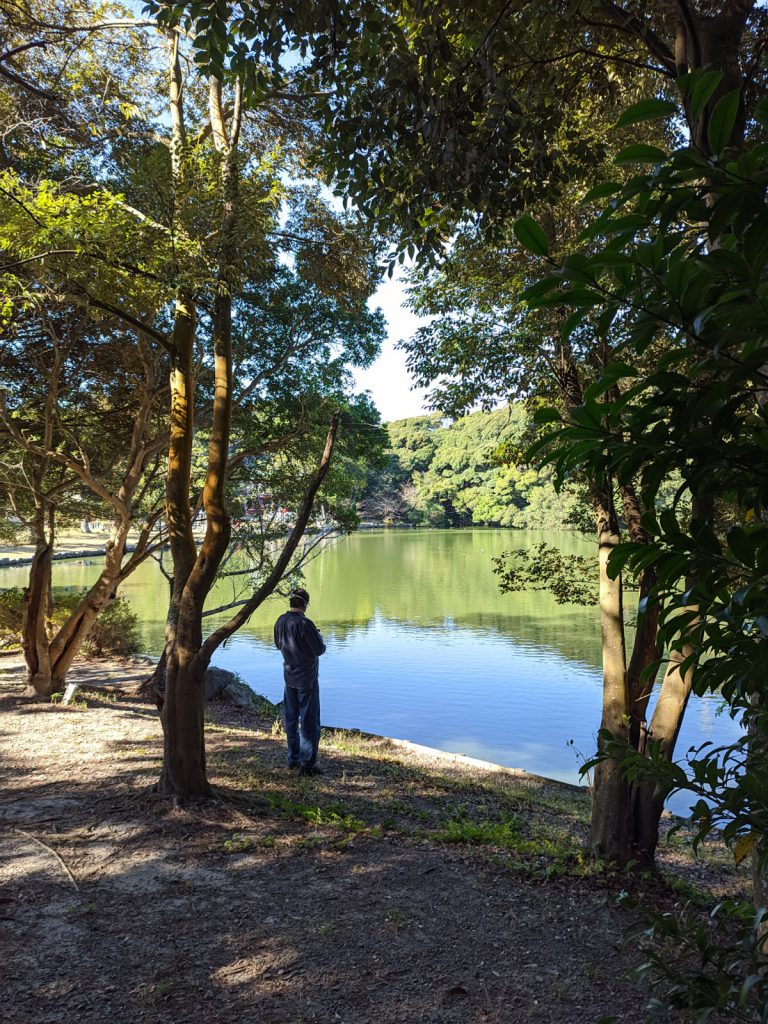The story goes that a large snake-dragon lives at the bottom of Sakuragaike Lake. It’s waiting. But where did this snake-dragon come from, and who is it waiting for? I’ll tell you about this still obscure myth — and nanafushigi — in this episode of Uncanny Japan.
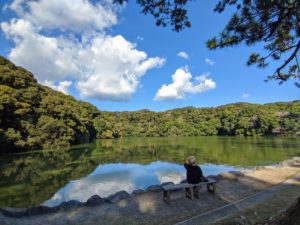
Hey hey, this is Thersa Matsuura and you’re listening to Uncanny Japan. How are you? You know, last episode aside, I’m feeling pretty good. I’d say powerful even. I’m also feeling like I want to revisit an topic I have been meaning to get to. But since the virus stopped all travel in it tracks I haven’t been out, even locally. Well, that’s changed. I’m vaccinated and boostered and Japan’s numbers are freakily low. So I made a little trip.
Do you remember the nanafushigi I talked about back in episode 35? Those strange happenings or mysterious occurrences that are associated with certain places, and usually take place in sevens. If your memory is serving you correctly, you’ll recall after I introduced them, I did a show on two nanafushigi in my prefecture: The Rock that Cries at Night (Yonaki Ishi) and Koumare Ishi, these perfectly round stones that appear from this cliff and slowly work their way to the surface, only to fall into the river below, thus predicting the death of the head abbott of the nearby temple. Anyway, those are episodes 36 and 59 if you want to revisit them.
Here it is show number 88 and I can finally leave my house again. It’s time to do another nanafushigi. Today I’m going to tell you about a strange lake with a giant snake-dragon living deep in its depths, waiting. How did it get there and what is it waiting for? Well, I’m going to get to that real soon.
But first…
Well, hello there again. Let me start by making a correction. A couple episodes ago I talked about the korori, the yokai that brought cholera to Japan and killed a whole bunch of people. I said that Hiroshige Utagawa probably died of cholera, and that you’ll remember him as being the artist who created that iconic ukiyo-e, The Great Wave.
Wrong.
A very kind and interesting gentleman-listener from Seattle caught that hefty mistake I made and reached out. While it is true that it’s believed that Hiroshige fell victim to cholera, we all know that it was Hokusai who carved the woodblock of The Great Wave, not Hiroshige. Hiroshige created the 53 Stations of Tokaido, which I’m quite familiar with because I literally live in one of cities on the list, and very near two others. Thank you, Dale, for emailing me and letting me know, also for being a really nice guy.
One more tidbit of news, I’m planning a trip to Kyoto. I haven’t been in forever and since travel is okay again, I’m dying to go. Only, I’m overwhelmed with it all and want to go everywhere, do everything, so I’m a little stuck in my planning. This will also be a research trip, not just me sipping matcha on sweet-smelling tatami mats while gazing at the moon reflected in the pool of a Zen temple.
So if any of you have any recommendations, places you’ve been and loved or want to visit terribly because scary this or cool Buddhist that, but…you know, can’t because of travel restrictions…please reach out let me know. Maybe we can do an episode on it. UncannyJapan@gmail.com, Twitter, Instagram, Facebook, website. Anywhere is fine.
The Sakuragaike Myth
Let’s get back to nanafushigi. I’m excited because this is one of those legends I’ve never seen translated into English or any other language, as far as I can tell. And while I knew some vague details about the story and have visited the lake in question dozens upon dozens of times, I didn’t know the real details until I did the research for this episode. As a matter of fact, there is so much interesting story here, I’m going to divide it into two parts. Part One, the main myth and Part Two some surrounding stories, why it’s mysterious, and how it’s still celebrated today.
Today’s mysterious happening is from a place called Sakuragaike. It’s a quaint little lake mostly surrounded by forest in a place called Omaezaki. Do you hear that? I didn’t even need to tell you. Yep. We woke up early and brought the binaural mics to the lake to see what kind of nature sounds we could get.
So aside from the idyllic lake, there’s a big torii gate nearby, a shrine that dates back to 584, and a wicked cool tree trunk that has grown low and twisted, and has been decorated over the years with vines, two eyes, horns, a tongue, and oddly has succulents growing all out of its face. It looks just like a dragon. The dragon from the legend no doubt. I’ll put up photos for you to see.
There are actually several different myths that have arisen from this small lake called Sakuragaike. But it all starts with one. A legend that goes something like this: Eight hundred years ago. Not here, but on the Mountain of Hiei in Kyoto – roughly 300 kilometers away – there practiced a very high level and respected monk named Kouen Ajari.
Kouen Ajari was also a very curious monk and a deep thinker. He had so many questions, like what happens to us after we die? Among others. Anyway, after years of study he began to get frustrated because he had all these unanswered questions and the more he studied the ancient Buddhist texts the more questions he had. He said something to the effect of: “I wish I had been born three thousands years ago. Then I could have traveled to India, met the Buddha himself, and gotten the answers.” Side note: One name for the Buddha in Japanese is oshaka-sama.
All this really bummed Kouen-sama out. That is until he came across another Buddhist text that mentioned a future Buddha called Miroku Bosatsu in Japanese, or Maitreya Bodhisattva. To which Kouen Ajyari had a thought something like: “You mean another Buddha is coming? Well, this is great news. I’ve got this growing list of things to ask.”
Except, there was one catch. The Miroku Bosatsu is believed to appear 5,670 million years after the death of the Buddha as we know him, Oshaka-sama. Koen Ajari had a long, long, long wait ahead of him. Believing in reincarnation he at first thought, well, maybe I’ll be reborn again at the time the future Buddha appears, then I can ask my questions. But then he remembered that when you died you forget your previous life. So he’d forget all those burning questions. That wouldn’t work. But Koen Ajari wasn’t a man to give up. Let’s forget for a moment that non-attachment was one of Buddha’s main things. Koen Ajari wouldn’t let this go.
Big Snake, Dragon, or Snake-Dragon?
Kouen-sama asked himself what’s the longest living creature on earth? His answer was big snakes, of course! I need to interrupt our story for a moment to say I’ve read several different renditions and retellings of this old myth and some say big snake, others say dragon. It feels like the original story used the characters for big and snake, and then over the 800 years of retelling, it became ryuu (龍) or dragon.
Also, some fun kanji and mythical trivia for you: the characters for big snake in Japanese are not pronounced oohebi (大蛇) , like I thought, but daija. And when you do an image search for daija, you see these things are huge! So daija isn’t just a big snake, it’s a mythical creature.
I also learned there’s another pronunciation: orochi (大蛇), and that there is a Japanese myth called Yamata no Orochi (which I should probably do a show on) and it’s about a legendary 8-headed snake. Some of the artwork about the tale features what looks like a dragon to me. I’m guessing here, I didn’t read this anywhere, but I kind of suspect that maybe the character for dragon hadn’t entered Japan from China of these really old myths, so big snake it was.
Okay, back to the story. So Kouen Ajari is convinced if he can turn himself into a big snake or dragon — I’ll refer to as snake-dragon from here on out — then he can just hang out somewhere until the future Buddha arrives, then poof, transform back into a monk and ask all those niggling questions he’s been collecting.
Kouen Ajari’s Other Problem
Alas, Kouen Ajari ran into another problem. At that time on Hiei-zan there was a big (again mythical) bird that would swoop down, pluck up and eat a single daija, every day. It was not a safe place for a snake dragon to hang out and wait 5,670 million years. Given the number of snake-dragons and the number of years he had to wait, the odds weren’t good he’d survive.
But our Kouen-sama was nothing if not tenacious. He wasn’t going to give up that easily. He gathered his apprentice monks (called deshi/弟子 in Japanese, btw) and set them all off to walk the four corners of Japan in order to find a safe pond or lake that a dedicated daija might hide away until the future Buddha arrived. So they did. It took a while as you can imagine. And there wasn’t much luck until one of the deshi, a monk named Chuuki, while traveling, had a dream. In the dream the Buddha came to him and said, I’m paraphrasing here, “There’s a good place for your master to reside. It’s called Sakuragaike. Check it out.” And so he did.
Chuuki’s Dream
After asking around Chuuki finally located Sakuragaike and it was perfect. It was on high ground. The west, north, and east directions were all protected by forests, and the south faced the ocean. On top of that it was gorgeous and isolated.
Chuuki got himself a bamboo tarai — which is a kind of small tub — and filled it with water from the lake. He then made the long trip back to Hiei-zan. Kouen Ajari was thrilled upon hearing his story, the dream, the perfect hiding place. Okay, he said when Chuuki was finished talking, I’m ready to go. Right now? His deshi asked. Right now, he said.
Kouen-sama told all his gathered deshi to keep up with their Buddhist studies and meditations. He wished them well and took that tarai full of water from Sakuragaike and poured some on into his cupped hand. He swirled it around, while reciting a sutra. Soon black smoke began to billow from his hand until it completely engulfed him.
The deshi were all getting very nervous, coughing, and scared when suddenly the smoke cleared and instead if their master a giant snake-dragon remained. You can imagine how they all freaked out. Because they did. Calling out the name of their teacher, running around, screaming. But all the same, Kouen Ajari, now a daija, rose into the air and flew to Sakuragaike.
Arriving at Sakuragaike
He arrived there later in the evening. Accompanying him was a great storm, winds and rain seemingly out of nowhere. The nearby villagers were like what’s going on? Then the bad weather stopped as quickly as it had started and the lake was as peaceful again.
Hmm. Later word spread there was a great monk in the body of a snake-dragon living at the bottom of the lake.
Twenty Years Later
Twenty years later, one of Kouen Ajari’s deshi became a great monk himself. His name was Hounen. He decided one day to take three of his apprentices and visit Sakuragaike to pay Kouen Ajari a visit. After reaching the lovely little lake, the four monks sat on the grass and meditated and chanted sutras, asking for Kouen Ajari to show himself. They wanted to say hi.
They called him once, twice, and on the third time the calm lake began to kick up waves and smoke and suddenly, what do you know, there floating above the water was Kouen Ajari in his old human form.
“Oh, Hounen, thank you for coming all this way. Here, follow me.”
And with that, the lake parted in two and a path led down, down, down to the deep, deep bottom of the lake.
What did they find waiting there? What happened next? Well, you can find out that and more on the next episode of Uncanny Japan. You see, this is getting really long and I don’t want to cut out any of the details of the story, because I just love that it’s over 800 years old and we still have names and quotes even! So I will leave you here hanging on to this cliffhanger by your fingernails for now.
Remember if you’d like to support the show and get some extras, you can do so over on Patreon, for as little as two dollars a month. However, $5 a month gets you all the folktales I’m translating and retelling from those old books I found, as well as, other random goodies: recipes and the binaurally miked backgrounds, for example.
You can also join the Uncanny Japan Discord server that Richard set up. How to do that is in the show notes of this episode, which you can find on the Uncanny Japan website. Or if your patreon is connected to your Discord and you’ve given it permission, it automatically adds you to out cheerful, quirky little group.
Thank you so much for listening and I will talk to you again real soon.
Credits
Intro and outro music by Julyan Ray Matsuura
Electro Storm by Mikael Hellman
Link: https://filmmusic.io/song/8463-electro-storm
License: https://filmmusic.io/standard-license

